Many years ago, I worked as the editor of a small weekly newspaper in Salida, Colo. — it was the flagship publication for a modest “chain” of newspapers stretching north to Buena Vista and Leadville and northeast, over Trout Creek Pass to the little town of Fairplay. It was the week after Thanksgiving and a buddy of mine, Dale, was planning a holiday trip home to Iowa (or maybe Indiana or Ohio — some Midwestern stronghold), and he wanted to take some trout home to share with his family.
Well above Salida to the southwest, at the southern end of the Sawatch Range, lies a little family fishery — it’s a mountain lake that’s generally easy to get to. During summer, its banks are lined with kids and families dunking worms for planted rainbows. I loved this little lake, because it kept the casual fishing crowd away from my hidden trout streams that were just a few miles farther up the road. Just after Thanksgiving this particular year, the lake froze early, and the crowds were gone. This was ideal, as my friend wanted to haul up a portable ice-fishing shanty. The plan was for each of us to catch our limit of holdover rainbows so he could take them home, cut them into small filets, and vacuum pack them for the ride home to Ohio. Or Indiana. Or wherever.
We got to the lake pretty early, and we had to drive through a couple of inches of fresh snow to do it. We parked his old Blazer near the boat launch and he stepped out onto the ice to inspect its thickness. I looked out over the freshly frozen lake — the east side of the lake was iced over pretty well, but on the west side, where the lake got early sun, about a fifth of the lake remained open. His booted foot crunched through the ice on his first step, but he was able to lift himself onto the ice with his second step. He took a few cautious steps farther out, looked back at me and declared, “It’s all good!”
A few minutes later, we had all the gear out on the ice, the little tent set up and two holes drilled. We dunked some mealworms down the holes using two small ice-fishing rigs. Dale declared we needed the ice to be two inches thick to ensure safety — after drilling the first hole, he stuck his hand in the water and felt the wall of the hole.
“Yeah,” he said. “I guess that’s about right. We’ll be OK.”
I was unconcerned. This was Dale’s show. I just turned out ready to fish … and drink beer, of course.
And I’d never gone ice fishing in an ice shanty before. Right then and there, I vowed I’d never go ice fishing without one from then on. The dark armored vinyl walls locked out all the outside light — the only light that came into the shanty glowed from under the ice. It was a surreal experience. I could see my baited hook through the hole in the ice, dancing in the almost-frozen water, nearly 20 feet down. And when a stocked rainbow would cruise by and show interest, I could watch it inspect the bait and, more often than not, eat it.
The only thing even remotely inconvenient about the process that day is that I had to put my beer down to reel the trout in.
And we did some reeling. It got to be where we were pretty picky about the fish we’d keep. Smaller trout … say … 10 inches or smaller were quickly released. We cogitated over a few fish in the 12-inch range, and by the time an hour passed, we’d caught probably 15 fish, but kept a modest half dozen. We’d simply slip open the side door of the shanty and toss the harvested trout out onto the ice for collection when we were ready to call it a day.
After tossing our sixth trout out through the vinyl door, I heard the ice crack for the first time.
Now, I knew enough to know that, over the course of a day, ice on any body of water, regardless of its thickness, will shift and groan and crack. I spent a day fishing for lake trout on Taylor Reservoir, high in the mountains above Gunnison, where I had to drill down a good 20 inches with a hand auger before I punched through to water. Even then, where it would have been safe to drive a truck out on the ice, the surface creaked and cracked audibly and ominously all day long.
But this one felt different. Like … I felt it under my feet.
“Don’t worry,” Dale said. “Totally normal.”
Yup. Totally normal, I thought, as I crushed one empty Olympia can and opened another one. We kept fishing, and we kept catching. As we got closer and closer to our two-man limit of 12 fish (the limit at the time was six per person, per day), I started to notice a thin sheen of water hovering over the ice under our feet. Occasionally the ice would crack and groan, sometimes more audibly than what I would have normally been happy with. But I was drinking beer and catching fish. It was all good.
Finally, after a couple of hours and nearly a whole case of cheap Olympia, we caught trout No. 12 — a fat 14-incher that just looked delicious. As Dale started to reel up the lines and get the shanty ready to break down, I pulled open the side door of the shanty just enough to toss the fish out onto the ice. As usual, I didn’t bother to look outside.
Then instead of hearing a “thunk!” when the fish hit the ice, I heard an audible splash.
I opened the side door of the shanty and looked outside.
“Oh, shit, Dale,” I said through a beer-induced haze. “We’re on an iceberg. We’re floating.”
Dale looked at me quizzically, as if what I was saying didn’t compute. Then he looked down at the thin sheen of water hovering above the ice underfoot, and I saw the light bulb come on.
“Oh, shit,” he said. I moved gingerly off my little 5-gallon bucket and opened the side flap of the little vinyl tent. I stepped outside and took in the enormity of our predicament. We were, indeed, floating on a shrinking island of ice. About half of the fish we’d tossed out onto the ice for eventual cleaning were gone, presumably liberated back into the lake as water slowly lapped at the edges of our sanctuary.
About 200 yards in the distance, Dale’s red Blazer seemed to stare out at us with a scolding smirk. If it could have spoken, it would have said something rhetorical, like, “Aren’t you a couple of God-damned idiots?”
And we certainly were. Early ice is dangerous ice, I was always told. But youthful hubris and the prospect of fishing and drinking a day away shoved whatever caution I possessed to deep recesses of my brain. As I stood there, virtually helpless, I remembered that first step onto the ice Dale took and how his foot crunched through the bank ice. Yeah, that should have been taken as a sign.
And we stood there, two shell-shocked 20-somethings in full snow attire, trying to figure out what the hell to do. Would our little island float to the bank with us intact? Would it slowly melt and deliver us into the frozen depths of the lake, where our blue corpses would be pulled off the bottom after ice-out in May?
I started stripping down — I knew it would be cold, but I also knew I could at least swim to the main body of ice, which remained, as far as I could tell, intact. Dale, noticing me stripping, nodded his head and started doing the same thing. To hell with the shanty. It was time to save our own asses.
Then, as if our willingness to dive into the almost-frozen lake spurred the Fates into action, a little breeze came up, and a chop took hold on the water. At first I was terrified — certainly, the wind would push water over the thin cap of ice on which we sheltered, and our swim would happen sooner rather than later. And, honestly, I wasn’t mentally prepared to dive in—I hadn’t yet reached full panic mode.
But that wind. Oh, that lovely wind.
I watched as a gust of high-country wind used that wonderful little ice shanty as a makeshift sail. Dale held the edge of the vinyl shelter and I remember watching it blow up like a balloon as the wind grabbed it. And our shrinking island of ice started to move toward the middle of the lake … toward the frozen heart of the water body. In minutes flat, our island of ice bumped audibly against the larger ice sheet. I slowly started to inch my way toward the main body of ice, listening for noisy cracks and groans from the wayward sheet of ice upon which we’d spent the better part of a day. Nothing.
I looked at Dale, who had the shanty free from its anchors and was busy sliding it over the ice toward me. I nodded. Yes, I thought. Let’s save the shanty (mostly because my snowpants, my sweatshirt and my parka were in it). Like Dale, I was standing on the ice in my snow boots and my boxer shorts sporting raw, red skin and a couple of impressive glass cutters on my chest.
We stepped simultaneously from the wayward sheet of ice onto the more solid, more dependable ice and pulled the shanty after us. Just as it was about to clear the small gap between the two chunks of ice, the hand auger slipped out the far door of the shanty. I remember watching it slowly disappear into dark water that reflected the deep, gray late-November sky.
Dale and I looked at each other, each of us with wild, bewildered eyes. An ice auger? Small price to pay.
As we sat in the front seat of the Blazer, the shanty still erected in the little parking lot, we warmed ourselves in front of the little truck’s generous heater vents. While we had managed to save our winter gear, it was soaked through. The full-throated heater washed warm air over our nearly naked bodies, and the feeling started to return to our extremities. It took a few minutes, but the relieved giggles turned into full-on chortles. Reliving the adventure was much more fun than that first go of it.
Then Dale’s face went from relieved to completely serious. It was as if this near-death, certainly hypothermic episode never actually happened.
“We need to come back this weekend,” he said with a concerned look on his face. “I still need to take some fish home.”





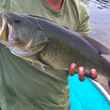





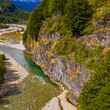




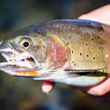




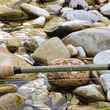




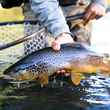
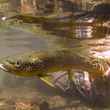


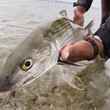

Comments
Kerry M Gubits replied on Permalink
Great story! Fabulous "Oh shit!" moment!
Arthur Howe replied on Permalink
Please, no less than 4 inches of consistent ice before heading out. Be aware of thermal springs, currents, and feeder streams, among others, that affect this. Good story, and you were damn lucky! I'm a professional, commercial ice harvester, as well as an angler.
Art Howe, Outdoor Safety Instructor
Pages